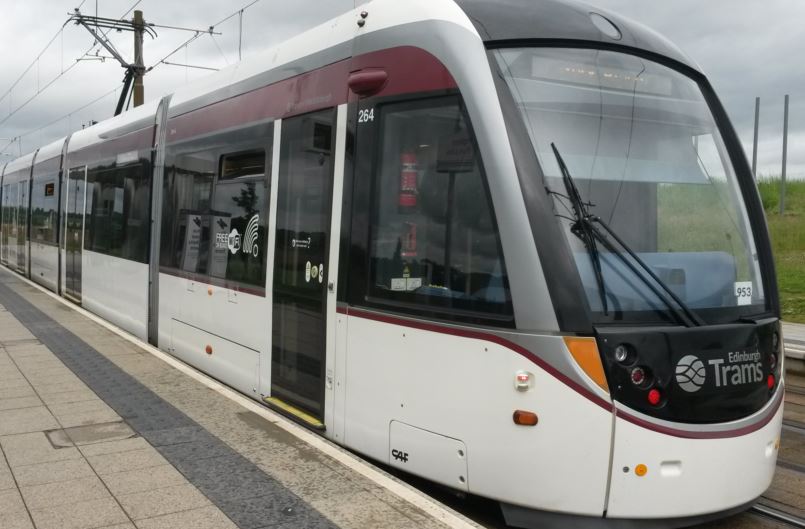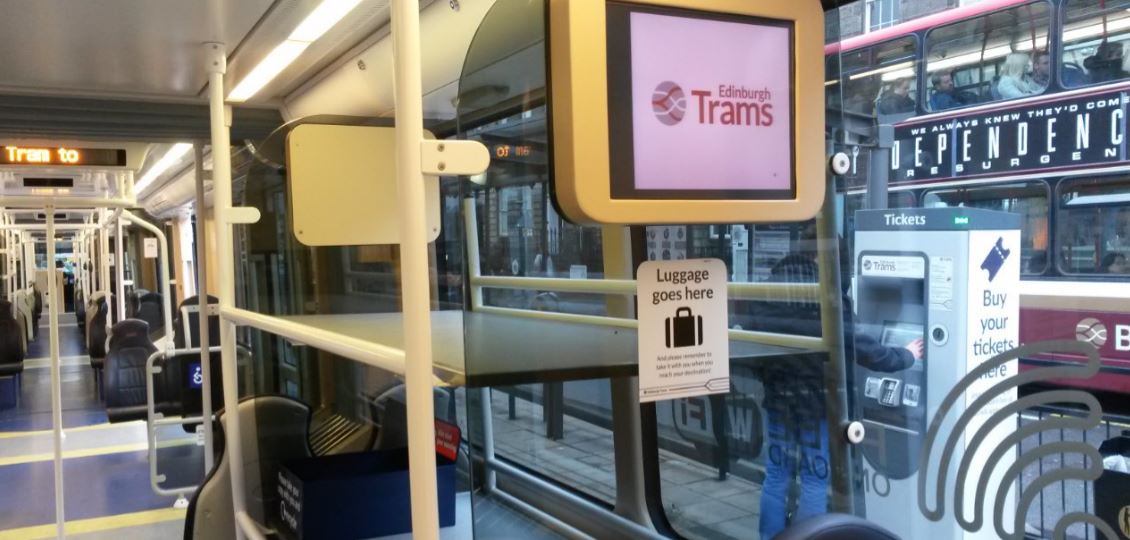Railfuture Scotland
Edinburgh Trams
Railfuture campaigns for a 'bigger and better railway'. By 'railway' we also mean trams, light rail and underground systems as well as the national railway network. Therefore we support and campaign for more tram systems and expansions to existing ones, and this is explained in our book Britain's Growing Railway (see [SHOP] to buy the book and find out more about it).
Tram systems returned to Britain in 1992 (ignoring the Blackpool system, which never closed, but had remained as a heritage system, although completely modernised in recent years). Government support for new systems has alternated between support and outright opposition, primary because some politicans believe (incorrectly in Railfuture's view) that buses can do a good job, and the cost and construction overruns seen on several schemes. Undoubtedly by far the worst construction cost increase was on the Edinburgh Trams and as a result the first line was curtailed.
Extension approved

The good news is that depsite the doubling in cost for a curtailed scheme that was delivered years late, Edinburgh's trams have been popular with the public. More journeys have been made than envisaged and, crucially, the trams ran at a profit sooner than had been expected. This success along with the rate of growth forecast for Edinburgh over the coming years - and the fact that some works on the extension had already been done (and then covered over) plus having bought more trams than they need for the short line - has encouraged Edinburgh City Council to give approval in March 2019 (voting 36 to 26 in favour) to the £207m 4.5km extension of the tram system following studies, analysis and heavy scrutiny to ensure that the extension will be delivered on time and on budget. (In fairness to the trams, when constructing the initial phase, once the original problems with the contractor were resolved the project was successfully completed. An Edinburgh Tram Inquiry chaired by Lord Hardie was set-up to find out the causes for the problems.)
The extension will be funded by borrowed and repaid revenue from future ticket sales, and Lothian Buses will also provide a £20m dividend. Construction, which was scheduled to start on 10 November 2019, was expected to take three years, with completion in late summer 2022 followed by around several months of testing, opening to the public in spring 2023. Despite the COVID-19 pandemic, which has delayed many construction projects, this target is set to be achieved, albeit on the very last day of what can be called 'spring'.
The extension has been approved partly because of Edinburgh's rapid population and economic growth experienced so far and predicted in the future:
- Over the next decade, Edinburgh and its surrounding area is expected to be home to a faster-growing population than anywhere else in Scotland. National Records of Scotland projections published in 2016 suggest the city should be planning for an additional 47,000 people by 2024 and an additional 102,000 by 2039 (20% increase)
- Number of households forecast to increase by over 38,000 (16%) by 2032. A quarter (25%) of this growth is forecast to occur in Leith Docks and Western Harbour area
- Employment levels in Edinburgh are projected to grow by 7.6% between 2013 and 2022.
Edinburgh Trams extension - progress so far
City of Edinburgh councillors had been looking at options to extend the Edinburgh tram network to Newhaven, Ocean Terminal or the foot of Leith Walk. All of these were on route '1a' (the first of several lines planned), which gained planning approved but was cancelled when the scheme was cut back to York Place to save money. A council report recommended an extension to Newhaven (the original phase '1a' limit) at a cost of £144.7m, and on 19th November 2015 Edinburgh City councillors voted to take the project to the next step - see BBC News Report (19/11/2015).
Edinburgh City Council authorised £3.25m to develop the project and a further £1.75m has also been set aside to secure land along line '1b'. On 21st September 2017 Edinburgh City Council approved the Outline Business Case for the 4.6km extension to Leith and Newhaven, provisionally budgeted at £165m. The planned works include eight new tram stops, the demolition of York Place tram stop, two substations, bridge works. The proposal had been closely scrutinised at length by members of all political groups on the council. At the end of October 2017 the council launched a comprehensive tendering process to secure up to two potential partners for the project. Two tenders were issued: lot 1 for the infrastructure and systems contract, and lot 2 - the Swept Path contract.
The winner of the infrastructure and systems contract will be responsible for bringing the Edinburgh tram to Newhaven and Leith. The Swept Path contract will be to clear the tram route of all below ground utilities and obstructions, with the necessary works being defined by the contractor awarded the lot 1 contract.
Seven contractors submitted applications to construct the extension (design and construction of all track, overhead line, tram stops, systems infrastructure, road infrastructure and public realm between York Place and Newhaven). Following a pre-qualification process, in March 2018 a shortlist of four companies was announced. The tender process took place during 2018, with the council agreeing that it would only consider giving final approval if satisfactory responses from potential contractors have been received. The two contractors recommended for award were Sacyr Farrans Neopul Joint Venture (SFNJV) for Infrastructure & Systems Contract (lot 1) and Morrison Utility Services Ltd (MUS Ltd) for the Swept Path Contract (lot 2).
The intervening time during the evaluation process provided a further 12 months of evidence of tram patronage. As expected passenger growth continued ahead of expectations. A key issue is the temporary disruption for businesses and residents along the route. This was worse that planned on the initial route because construction works overran. The council will undertake detailed work on traffic management arrangements and measures to mitigate the impact of future works.
A six-week public consultation exercise started in March 2018 that sought feedback on a) traffic management and business support plans for the construction period and b) the outline road layout for Leith Walk and the rest of the route. Further consultations took place until the end of 2018 (including one on proposed support for businesses affected by construction works). An independent survey carried out in Leith in November 2017 found that the majority of respondents believe Leith would benefit from the introduction of a tram.
Key points from the Edinburgh Trams extension outline business case
- Capital Cost estimated at £165.2m, including risk and inflation
- Patronage forecast to almost double in opening year to 14m, reflecting high population densities along the route
- For every £1 spent the economic return to the city is £1.64 (including wider economic benefits, including social inclusion) and completing the line will provide access to jobs and support business and opportunities in the area
- Estimated three-year construction period, including 18 months on Leith Walk, followed by approximately four months of testing and commissioning on new line.
- Significant proportion of major utility works have already been carried out - remainder carried out in conjunction with main infrastructure works, meaning no 'double dig'
Edinburgh Trams - photos from summer 2016

Tram ticket machines show destinations on route map
A nice feature on the Edinburgh Trams ticket vending machines (TVMs) is that rather than having a list of tram stops they show each stop as its position on the tram route so that the passenger touches the stop they want. Obviously something this simple is only possible on a small network. It may need redesigning if the tram route is extended.

A tram arrives at Ingliston Park & Ride stop. One stop before the Edinburgh Airport terminus it is the zone boundary between trams from the city centre. This means anyone going beyond this stop to the airport has to pay a substantially higher fare.

This is the inside of a tram looking out of the window when the tram was parked at the current terminus at York Street stop. The sign on the window shows that Wi-Fi is provided. At the time Edinburgh was one of only two systems offering free on-board Wi-Fi (the other was Manchester Metrolink).
All photos by Jerry Alderson.
Page last modified on Tuesday 07 March 2023.
Back to [HOME] page • Go to [DASHBOARD] page • Go to [INDEX] page
|
Support Our National Campaigning - Join Railfuture
Annual Rates: £20 individuals, £22 joint, £14 under 26 |
|
Page last changed on 26th May 2022.

